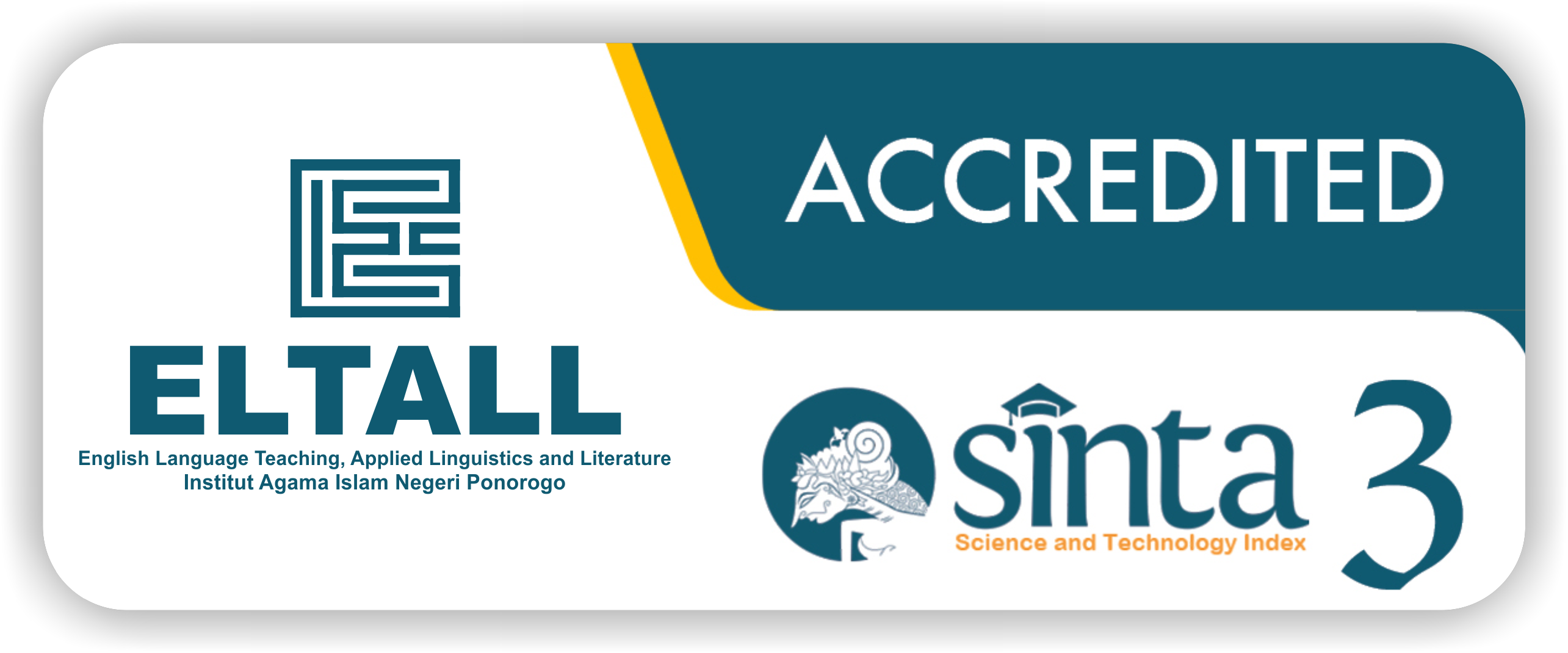CODE SWITCHING IN INDONESIA BILINGUAL EDUCATION
DOI:
https://doi.org/10.21154/eltall.v1i1.2120Keywords:
Code switching, Bilingual Education, International Secondary schoolAbstract
Indonesian government policy supports the international of education at the
secondary level, consequently more institutions have commenced bilingual programs.
Content is taught both in Bahasa Indonesia and English, making code-switching in
classroom discourse. The study was conducted at a single International school in
Semarang, East Java, Indonesia. This case study explored in what ways and under
what circumstances Indonesian teachers and learners use code-switching in the
selected bilingual classroom and semi structured interviews with six-bilingual class
students and teachers at an International secondary school in Semarang, East Java in
Indonesia are used to get the data. The finding shows Teachers’ and students’ codeswitching
demonstrated collectivist phatic functions ”“ for example, teachers codeswitched
to build rapport, remind students and reduce students’ anxiety, and students
code-switched to show their solidarity and concern for their peers. Thus,
interconnectedness was a key characteristic of code-switching by both teachers and
students. This study argues that code-switching is not just about language deficiency,
but involves intentional communicative purposes which support teaching and
learning. It can be concluded that code-switching can be a useful tool to bring about
understanding of unfamiliar concepts and processes as well as the language
associated with them.
References
Act of The Republic of Indonesia. (2013). Number 32 Year 2013 about the changes
of The
Government Policy Number 19 Year 2005 on the Standard of National
Education. Retrieved 20/05/2013 from
http://sipuu.setkab.go.id/PUUdoc/173768/PP0322013.pdf.
Arthur, J. & Martin, P. (2006). Accomplishing lessons in postcolonial classrooms:
Comparative
perspectives from Botswana and Brunei Darussalam. Comparative
Education, 42(2), 177-202.
Andersson, I. & Rusanganwa, J. (2011). Language and space in a multilingual
undergraduate
physics classroom in Rwanda. International Journal of Bilingual Education
and Bilingualism, 14(6), 751-764.
Baker, C. (2001). Foundations of bilingual education and bilingualism. Bristol:
Multilingual
Matters Limited.
Blackburn, A.M. (2018). Cognitive Impact of Bilingualism and Language Habits at
the Bordersof Cultures and Nations. In: Inquiries into Literacy Learning and Cultural
Competencies
in a World of Borders (ed. T. Huber and P.S. Roberson),141---
Charlotte,NC:
Information Age Publishing.
Creese, A. & Blackledge, A. (2010). Translanguaging in the bilingual classroom: A
pedagogy for
learning and teaching? The Modern Language Journal, 94(1), 103- 115.
Cohen, L., Manion, L. & Morrison, K. (2011). Research methods in education (7th
Edn.). London: Routledge Falmer.
Cahyono, B. & Widiati, U. (2004). The tapestry of English language teaching and
learning in
Indonesia. Malang: State University of Malang Press.
Ferguson, G. (2003). Classroom code-switching in post-colonial contexts:
Functions, attitudes
and policies. AILA review, 16(1), 38-51.
Ferguson, G. (2009). What next? Towards an agenda for classroom code-switching
research.
International Journal of Bilingual Education and Bilingualism, 12(2), 231-
GarcÃa, O., & Kleifgen,J. (2018). Educating Emergent Bilinguals: Policies, programs
and
Practices for English Learners. (2nd ed.). New York, NY: Teachers College
Press.
Kirkpatrick, A. (2014a). Afterword. In R. Barnard, & J. McLellan (Eds.), Code
switching in
university English-medium classes: Asian perspectives (pp. 214-221).
Bristol: Multilingual Matters.
Lin, A. (2008). Code-switching in the classroom: Research paradigms and
approaches. In K. A.
King & N. H. Hornberger (Eds.), Encyclopedia of language and education
(pp. 273-286). Boston: Springer US.
Levine, G.S. (2011). Code choice in the language classroom. Bristol: Multilingual
Matters.
Martin, N. (2011). Code-switching in Indonesian as a second language classrooms:
Codeswitching
between Indonesian and English. Saarbrücken: Lap Lambert.
Moodley, V. (2007). Code-switching in the multilingual English first language
classroom.
International Journal of Bilingual Education and Bilingualism, 10(6), 707-
Macaro, E. (2014). Where should we be going with classroom code switching
research? In R.
Barnard & J. McLellan (Eds.), Code-switching in university English-medium
classes: Asian perspectives (pp. 10-23). Bristol: Multilingual Matters.
Palmer, D.K. (2009). Code-switching and symbolic power in a second-grade twoway
classroom: A teacher's motivation system gone awry. Bilingual Research
Journal, 32(1), 42-59.
Rezvani, E. & Rasekh, A. (2011). Code-switching in Iranian elementary EFL
classrooms: An
exploratory investigation. English Language Teaching, 4(1), 18- 25.
Tien, C. & Li, D.C.S. (2014). Code-switching in a university in Taiwan. In R. Barnard
& J.
McLellan (Eds.), Code-switching in university English-medium classes Asian
perspectives (pp. 92-104). Bristol: Multilingual Matters.
Truckenbrodt, A. & De Courcy, M. (2002). Implementing a bilingual program.
Melbourne:
Association of Independent Schools of Victoria.
Downloads
Published
Issue
Section
License
All articles published in ELTALL (English Language Teaching, Applied Linguistics, and Literature Journal) are licensed under the Creative Commons Attribution-NonCommercial 4.0 International License (CC BY-NC 4.0).
Under this license, authors and readers are free to:
- Share. copy and redistribute the material in any medium or format
- Adapt. remix, transform, and build upon the material
Under the following terms:
- Attribution. You must give appropriate credit, provide a link to the license, and indicate if changes were made. You may do so in any reasonable manner but not in any way that suggests the licensor endorses you or your use.
- Non-Commercial. You may not use the material for commercial purposes.
Notices:
- The licensor cannot revoke these freedoms as long as you follow the license terms.
- No additional restrictions. You may not apply legal terms or technological measures that legally restrict others from doing anything the license permits.
For the full legal code of the license, please visit: https://creativecommons.org/licenses/by-nc/4.0/













